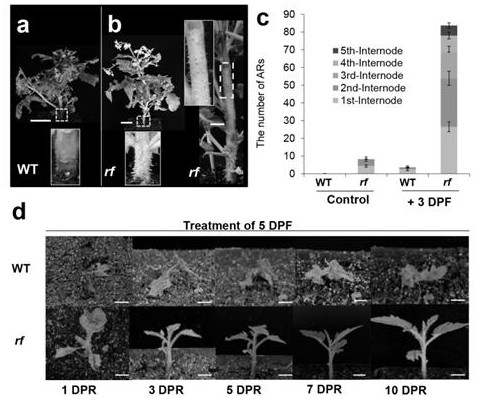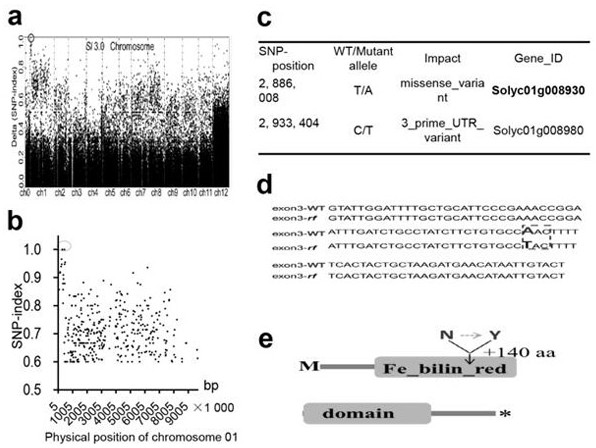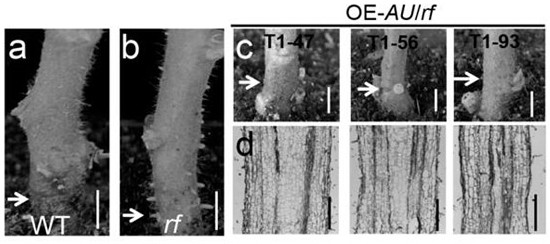A tomato waterlogging resistant gene rf and its application
A flood-resistant and tomato technology, applied in the field of agricultural biology, can solve problems such as plant growth, tomato seedling hypocotyl elongation, leaf yellowing, etc., and achieve the effects of improving absorption, improving flooding resistance, and maintaining biological yield.
- Summary
- Abstract
- Description
- Claims
- Application Information
AI Technical Summary
Problems solved by technology
Method used
Image
Examples
Embodiment 1
[0023] Example 1 rf Mutant and WT phenotypes and flooding resistance analysis;
[0024] obtained by comparing the Micro-Tom mutant library rf mutants and wild-type WT, where rf Mutants can autonomously develop adventitious root phenotypes ( figure 1 a, 1b). Our analysis of tomato WT and rf The mutants were subjected to water stress treatment respectively, and the number of adventitious roots of the plants in the 3d flooding period was counted and the growth of the plants in the 5th day of flooding was observed. See figure 1 , under normal growth conditions, tomato wild-type (WT) cannot produce the adventitious root phenotype (a), but rf The hypocotyls in the mutant can autonomously produce obvious aerial roots (b), when the plants are induced by waterlogging, rf The number of aerial roots on the mutants will increase significantly. When the flooding is induced for 3 days (+3 DPF, day post flooding), rf The most distal stem internodes of the mutant were also capable of ...
Embodiment 2
[0026] Example 2: rf Mapping of mutant candidate genes;
[0027] for positioning rf mutant candidate genes, will rf mutants were crossed with WT, and the F 1 Plant selfing produces F 2 group, and finally analyzed F using Chi-square test 2 Generation phenotype segregation ratio. Using the modified CTAB method from F 2 Genomic DNA was extracted from 55 mutant phenotype plants and 55 WT individual plants in the population. Equal amounts (ng) of DNA from single plants that passed the test were mixed, and mutant pools and WT pools were respectively constructed and sent to the company for BSA-seq. Finally, we performed linkage analysis on all SNP-indexes in the obtained clear-data, and selected SNP sites with SNP-index values close to 100% for mutation identification.
[0028] Using BSA sequencing, the candidate gene linkage group RF was located on the short arm of tomato chromosome 1 (a), and the analysis of the sites with SNP-index = 100% showed that only one SNP site wa...
Embodiment 3
[0029] Example 3: Verification of Genetic Complementation RF gene function;
[0030] for further exploration RF In mediating the biological functions in the occurrence of AR, we use Gateway® technology to rf The mutant candidate genes were constructed by genetic complementation to confirm the biological functions of the mapped genes. Candidate genes AU The full-length cDNA (SEQ ID NO.1) was cloned into an entry intermediate vector pDONR221. Then the candidate gene was cloned into the expression vector pHellsgate 8 driven by CAMV35s promoter. Finally, using Agrobacterium C58 to transform rf mutants that acquire OE- AU / rf transgenic plants.
[0031] from image 3 Genetic complementation experiments proved that in the mutant rf Medium overexpression AU After the gene, the occurrence of aerial roots can be completely and completely suppressed. Under normal conditions, neither the WT (a) nor the transgenic lines could produce aerial roots (c), slice analysis found ...
PUM
 Login to View More
Login to View More Abstract
Description
Claims
Application Information
 Login to View More
Login to View More - R&D
- Intellectual Property
- Life Sciences
- Materials
- Tech Scout
- Unparalleled Data Quality
- Higher Quality Content
- 60% Fewer Hallucinations
Browse by: Latest US Patents, China's latest patents, Technical Efficacy Thesaurus, Application Domain, Technology Topic, Popular Technical Reports.
© 2025 PatSnap. All rights reserved.Legal|Privacy policy|Modern Slavery Act Transparency Statement|Sitemap|About US| Contact US: help@patsnap.com



